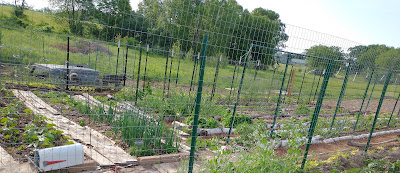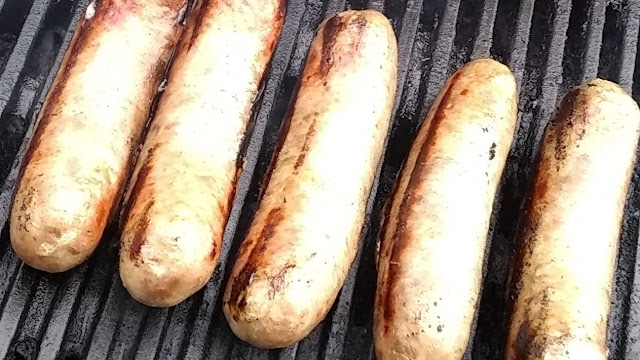Staying clean and killing germs seems to be on everyone's minds these days, and the number one way to do this is still good old soap. Our great-grandmothers knew how to make their own, and so can we (it's a lot easier now for us than it was for them!) Thanks to blenders, silicone molds, and slow cookers, soap making doesn't have to be an all-day, sweaty job, producing something that could burn your hands. It's a pretty simple process really, and with modern tools and ingredients we can be sure of a safe and effective product.
This is also the best way to know just what's in your soap - if you have chemical sensitivities, or just don't like all of the added colors and scents, making your own is a simple way to know exactly what's going on your family's skin. And if you're into essential oils, you can easily add them to your finished product to give it whatever scent or other properties you desire. I like to add some peppermint eo to mine in the winter, for that candy cane sort of scent (and also because it repels spiders and mice!). In the summer, I use rose geranium eo for its tick-repellant properties (there are a lot of lymes-carrying ticks where we live, and rose geranium is supposed to be one of the most potent natural tick repellants). But feel free to use whatever scents you like (rosemary for better memory? citrus for a cheerier mood?) Or use none at all! You're in total control!
Here's how I make my soap:
You'll need just two ingredients (well, three if you count water), olive oil (NOT extra virgin - for some reason this doesn't work well. You want the cheap stuff, or even
pomace grade if you can get it) and lye (for bar soap, you want
sodium hydroxide; for the liquid soap we're making here,
potassium hydroxide works better).
A word about lye: yes, this stuff is used as drain cleaner. Before saponification (chemically bonding with oil and turning into soap) it is very caustic and can cause chemical burns on skin. In the quantities we're using here, and in the contained environment of the blender, it's usually not overly dangerous, but it's still smart to be cautious, and not to do this around children and pets. If you do spill some on your skin, the best thing to do is to wash it off with soap and water (NOT vinegar). Once your soap is made, there will be no lye left - it will all have turned into soap (that's why all soap recipes should include more oil than lye; that way all of the lye has enough oil available to turn into soap, with a little extra just in case. This is called "superfatting" in the soaping world).
If you're still scared of lye, think of it like this: hydrogen and oxygen are extremely flammable. We all learned in grade school that a fire can't burn without oxygen (that's why candle snuffers work). But if you chemically bond the two, you get water, which we use to put out fires. The properties are completely changed. It's the same with lye in soap. Finished soap won't burn you.
You also want to make sure that your olive oil is pure olive oil, and not a blend with other oils. Each kind of oil or fat (fat is just oil that is solid at room temperature) has a different ratio for bonding with lye to make soap, so if you have different kinds of oils you need to adjust your recipe to account for this, or you could end up with soap that still contains unbonded lye and can burn your skin.
OK, now that we got all of the safety information out there, I can show you how easy (and safe!) it is to make your own soap.
Here's my recipe:
9.12 oz (258.55g) water
3.04 oz (86.18g)
lye (potassium hydroxide)
16 oz (453.59 g)
olive oil
It's very important to have an accurate scale (as I said above, you want to make sure you have more oil than lye in your soap). Measure out your ingredients carefully, and if in doubt, err on the side of more oil and water and less lye, just to be on the safe side. But better not to doubt!
1. Measure out your water into a glass jar you won't use for anything else (I just use an old salsa jar)
2. In a separate container, measure out your lye.
3. Pour the lye into the water (never the other way around, it could "volcano" and overflow the jar and burn your hands). I always step out onto the porch for this so that the toxic fumes that are created can dissipate.
4. Let the lye and water mixture sit for 5 minutes, until the mixture looks clear. You can stir it with a metal spoon to make sure everything blends well. Make sure to leave it somewhere where it's safe from children and pets. Also, be aware that this will get really hot! Never use plastic for this (it will melt, and bond with your lye to make something else) and be careful what you set it on.
5. Meanwhile, measure out your olive oil into your blender. Make sure everything is tight and working properly - you don't want it leaking! This is why I also put my blender in a pan; if it does leak, it will go into the pan and not all over the counter top. Lye is particularly hard on butcher block counter tops - ask me how I know!!!
6. When your lye is ready, bring it inside and pour the lye mixture into the olive oil (you might want to use an oven mitt - it will still be really hot!) Cover the blender and turn it on to a relatively low speed.
7. Wait. Soap made with pure olive oil can take 20-30 minutes to blend. Be patient. Remember, Grandma used to have to stir this by hand all day!
You'll know this part of the process is done when the soap "comes to trace". This means that the soap has a thick, pudding-like consistency, and that when you stir it with a spoon it leaves a trace of where the spoon has been, it doesn't just flatten out again like when it's fully liquid.
At this point, you have your soap base. If you wanted to make regular soap bars, you could pour this into your mold and let it sit for 4 weeks to finish saponifying ("cure"). It's not finished soap yet; all of the chemical reactions haven't fully happened.
Or, you can speed up the process with heat, which is what we'll do in the next step.
8. Pour the soap base into a slow cooker. I like to use my
Instant Pot, because the stainless steel insert doesn't react with the soap. I've done this in a regular Crock Pot, and the process eventually (after multiple batches of soap) ate away at the enamel and ruined the pot. I don't worry about having a separate pot for soap making, since once it's cooked I have finished soap, just like what I use to clean the pot after cooking.
You'll want to cook the soap base on low for several hours, stirring a couple times just to make sure it's cooking evenly and to see how it's coming along. It will go through several stages; it will start out like pudding, then look something like applesauce, and eventually get to a stage when it looks more like yellow mashed potatoes, with no liquid left. When it's thick like this, it's ready for the next step.
Again, this is a point where you have options. You can pour it into a mold and wait for it to cool to make bars (it's fully soap at this point, so you don't have to wait for it to cure), or you can mix in water to make liquid soap, as I'll show you in the next step.
9. Mix in 5-6 cups of water. This, for me, is the tricky part. Too much water, and you end up with runny soap (which you can cook off; just turn your slow cooker back on and let the excess water evaporate); too little, and your soap is too thick and gloppy and will clog up your pumper (to fix this, just add more water - which is much easier than boiling off excess, so I usually start with 5 cups of water and tweak from there).
Mixing it can also be a challenge; I like to use my stick blender, which does a pretty thorough job, but leaves the soap foamy, so you need to wait for it to settle before pouring it into its final container. A whisk and good old elbow grease will do the job, too, with less foam - but I'm lazy and have a stick blender.
As I mentioned before, you can add essential oils to your finished soap, either to the whole batch when you store it or to the pumper when you're ready to use it. You want to add them at the end, when your soap is cool, since essential oils are heat-sensitive.
And that's it! Kind of putzy, and it does take a while (most of it waiting while the blender runs or the soap cooks), but not really that hard. In only a few hours every month or so, you can keep your family stocked with soap!


































